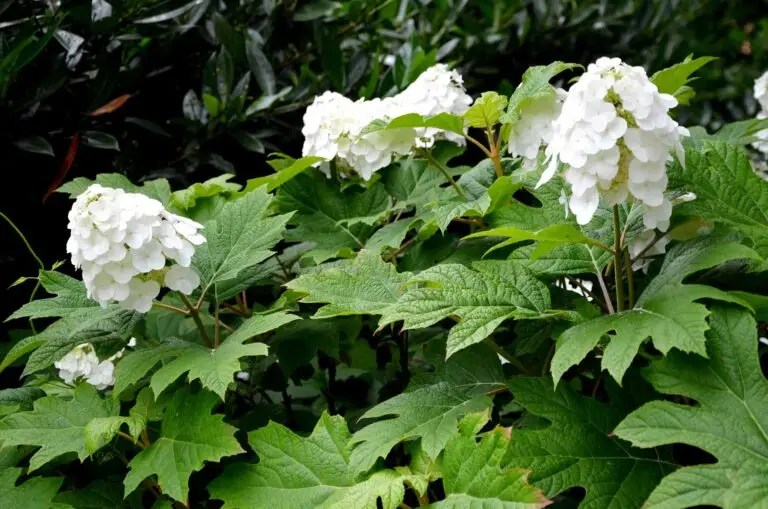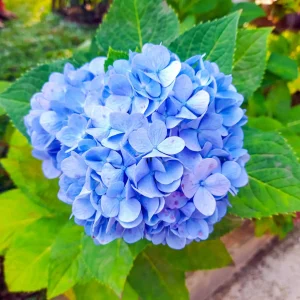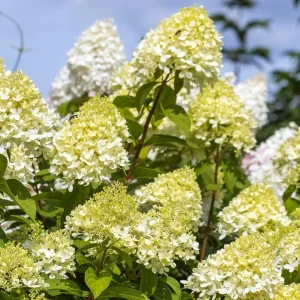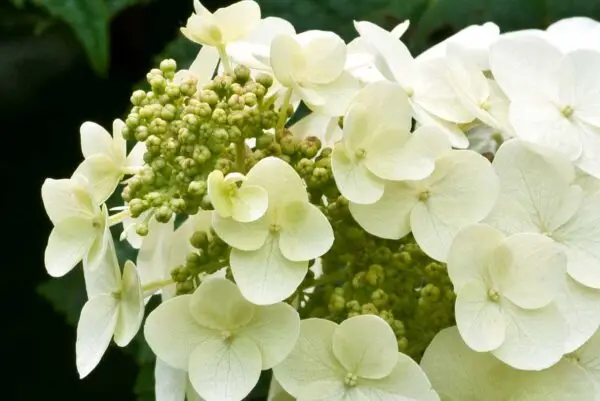Native Hydrangeas: A Beginner’s Guide
Hydrangeas signify a mythical American summer, as iconic as Fourth of July fireworks and barbecues. The orbed clusters of flowers hang from branches throughout June, July, and into fall and even sometimes make it into dried flower arrangements in the winter.
But here’s a surprising fact: only four species of hydrangeas are native to North America. Even more surprising? One of these native species has been cultivated to be pollen-free—a disaster for pollinators. Scroll on to learn more and find out where to find native hydrangeas.
- Full Sun, Part Sun
- Medium Shrub (6-10'), Tall Shrub (11-15')
- Summer flowers
- Easy to find

There are around 80 species of hydrangea worldwide—just four are found natively in North America.
Let’s talk about what native hydrangeas deliver.
The benefits of planting native hydrangeas
Plants native to North America have grown here for thousands—sometimes millions—of years. There are no better plants that know the soil, climate, and wildlife better than native plants.
Native plants also give a lot of benefits to busy gardeners. The benefits of planting native hydrangeas include:
- Fuss-free beauty. Native plants have planted themselves without human intervention for thousands of years. After the first year of getting established, they are happy with rain (one caveat: hydrangeas in full sun will need water during dry periods.)
- No PH-tinkering is required. Blue hydrangeas require extra fussy care. We’re talking about sending soil samples in and buying special fertilizers. Native hydrangeas require none of this.
- Multi-season beauty. Unlike many non-native hydrangeas, native hydrangeas’ leaves turn beautiful shades of red/orange/yellow in the fall.
- Multi-decade lifespans. Native hydrangeas can live for 50 years (or more) when planted in a good spot. Spend a few hours planting and enjoy resilient beauty for a lifetime.
- Pollinator support. Native hydrangeas are pollinator favorites. Those huge flowers create tiny cities in which pollinators can roam.
Meet the hydrangeas native to North America
These species are native to North America, including:

Smooth Hydrangea or Wild Hydrangea
Hydrangea arborescens
This species is native to the eastern United States and is known for its rounded clusters of white flowers that bloom in summer. It’s also the source plant for many sterile cultivars, including ‘Grandiflora’ and ‘Annabelle.’ Read on to learn more.

Oakleaf Hydrangea
Hydrangea quercifolia
Native to the southeastern United States, this gorgeous native hydrangea is instantly recognizable by its unique oak-shaped leaves. Its gorgeous cone-shaped clusters of white flowers can turn pinkish as they age.
Silverleaf or Snowy Hydrangea
Hydrangea radiata
Like Oakleaf, Silverleaf is native to the southeastern United States, especially the Appalachian region. It is known for its silver-backed leaves and wide, white lace-cap flowers.
There is also the Hydrangea cinerea, which, according to Mt. Cuba Center, is “rarely found in the horticultural trade.” It looks very similar to Smooth Hydrangea.
You’ve now met the native North American hydrangeas. 🥳
I know what you’re thinking.
What about blue hydrangeas? Are they native?
The blue orbs of flowers that decorate many Cape Cod real estate dreams are Bigleaf Hydrangeas (Hydrangea macrophylla). Bigleaf Hydrangeas are native to Japan, China, Korea, and Southeast Asia.
Bigleaf Hydrangea’s flowers turn different colors depending on the soil’s pH. There are countless articles, books, and videos about how to tinker with the soil’s pH to produce blue hydrangeas.
Wondering what other hydrangeas are non-native? Here are some non-native hydrangeas commonly found in North American gardens:
Non-native hydrangeas include…
The following species are native to different parts of Asia.
Planting native hydrangeas? Here’s a key tip to keep in mind.
When choosing native hydrangeas, it’s important to watch out for sterile cultivars—they may look beautiful, but they don’t offer any pollen for pollinators.
Understanding hydrangea flower clusters = spotting sterile hydrangeas
Hydrangeas produce flower clusters known as panicles. These panicle clusters typically contain two types of flowers:
This sterile-fertile combination allows the plant to attract pollinators with its sterile flowers while ensuring reproductive success through its fertile flowers.
I think I know your next question…
Why do the sterile, pollen-less flowers on hydrangeas exist?
Matt Candeias, of the blog In Defense of Plants, says it beautifully (bolding is our own):
“Flowers are essentially billboards. They are saying to potential pollinators ‘hey, I’m full of energy-rich food and totally worth visiting.’ However, flowers are costly to produce and maintain. Reproduction isn’t cheap, which has led some plants to take a more cost-effective route. In the genus Hydrangea, this means producing large, showy sterile flowers that draw attention to their smaller, less gaudy fertile flowers.”
Now, when we take a step back and look at an Oakleaf Hydrangea panicle, we can see the two levels of flowers working together:

The problem with some cultivar hydrangeas
Most cultivar hydrangeas are bred to be sterile.
Humans have been cultivating plants for centuries, selecting for traits like bigger blooms or longer-lasting flowers. When a plant is intentionally bred or modified in this way, it’s called a cultivar. (Curious about cultivars? Check out our short cultivar overview.)
To create hydrangeas with the showiest blooms, most cultivars are designed to produce only sterile flowers. These sterile flowers don’t produce pollen or seeds. By removing the fertile flowers, the sterile blooms take center stage, and because they don’t go to seed, they stay on the plant longer.
Sterile cultivars = No pollen for pollinators
Here’s the issue: without fertile flowers, hydrangeas—whether native or non-native—become completely sterile and offer no pollen. These sterile plants might look beautiful, but for pollinators, they’re an empty desert.
According to the Native Plant Trust, “While the leaves surely feed insect herbivores, the sterile flowers are of no use to pollinators.”
Unless you’re familiar with this botanical detail, you might think you’re helping pollinators by planting hydrangeas with big, showy blooms. Unfortunately, many of the most popular hydrangeas in gardens today are sterile cultivars.
Examples of sterile hydrangea cultivars
Some of the best-known sterile hydrangeas come from the native Smooth Hydrangea (Hydrangea arborescens), including:
According to Mt Cuba’s research report on wild hydrangeas, ‘Annabelle’ and ‘Grandiflora’ were naturally occurring cultivars first noticed, propagated, marketed, and sold in the early 1900s. Today, they’re everywhere—classic garden staples.
Sadly, these staples are pollinator deserts. Take a walk through the Northeast, Mid-Atlantic, or Midwest in summer, and you’ll start noticing just how much landscaping has been dominated by these “beautiful” but ecologically empty plants. They may look great, but they come at a huge cost to pollinators.
A better way to grow hydrangeas: stick to fertile native options
As you build your garden, choosing native hydrangeas is a simple way to make a positive impact. Avoid sterile cultivars whenever possible and opt for pollinator-friendly varieties.
Start by visiting our profile of an overlooked garden gem: Oakleaf Hydrangea.
Native vs. Cultivar
Plant true native plants whenever possible. Cultivars (short for CULTivated VARieties) are selected by humans and often do not offer the same benefits to bugs, birds, and animals that native plants do.
What are good pairings for native hydrangeas?
There are countless native flowers, shrubs, and trees that have happily grown alongside native North American hydrangeas for thousands—even millions—of years. Here are some other iconic native flowers that are well worth pairing in our gardens:
Hydrangeas are iconic plants, known for their showy flowers and easy care. The Asian species have hogged the spotlight for far too long. Let’s plant native hydrangeas in our gardens and spread the word that the non-native and pollinator-free cultivars are pretty but come empty-handed to the pollinator party. Stop by some other well-known native guides (below) to learn more about the history and benefits of native plants. Happy planting!
Sources
- Hoadley, Sam. Mt. Cuba Center, Research Report: Wild Hydrangea for the Mid-Atlantic Region. (PDF).
- “Hydrangea Arborescens (Hills of Snow, Hortensia, Hydrangea, Sevenbark, Seven Bark, Smooth Hydrangea, Wild Hydrangea) | North Carolina Extension Gardener Plant Toolbox,” n.d. https://plants.ces.ncsu.edu/plants/hydrangea-arborescens/.
- Ito, T., Aoki, D., Fukushima, K. et al. Direct mapping of hydrangea blue-complex in sepal tissues of Hydrangea macrophylla. Sci Rep 9, 5450 (2019). https://doi.org/10.1038/s41598-019-41968-7
- Endless Summer. “Soil Testing: How to Test Your Garden Soil pH and Identify Soil Types | Endless Summer,” May 28, 2024. https://endlesssummerhydrangeas.com/resource/hydrangea-soil/.
- Welsh, Kelly. “Hydrangea – Norfolk Botanical Garden.” Norfolk Botanical Garden, January 1, 2018. https://norfolkbotanicalgarden.org/collections/hydrangea/.
- Missouri Botanical Garden. “Hydrangea Paniculata ‘Grandiflora’ – Plant Finder.”
- “Hydrangea Paniculata ‘Grandiflora’ (Peegee Hydrangea).” North Carolina Extension Gardener Plant Toolbox.
- Britannica, T. Editors of Encyclopaedia. “sepal.” Encyclopedia Britannica, April 28, 2023. https://www.britannica.com/science/sepal.
- New England Wild Flower Society (http://plantfinder.nativeplanttrust.org). “Hydrangea Arborescens Annabelle.” New England Wild Flower Society, n.d. https://plantfinder.nativeplanttrust.org/plant/Hydrangea-arborescens-Annabelle.
- “The Sterile Flowers of Hydrangea.” In Defense of Plants, February 28, 2021. https://www.indefenseofplants.com/blog/2017/6/20/the-sterile-flowers-of-hydrangea.
- Mt. Cuba Center. “Wild Hydrangea for the Mid-Atlantic Region – Mt. Cuba Center,” January 27, 2022. https://mtcubacenter.org/trials/wild-hydrangea-for-the-mid-atlantic-region/.
- Beaulieu, David. “How to Grow and Care for Oakleaf Hydrangea.” The Spruce, July 29, 2024. https://www.thespruce.com/summer-blooming-oakleaf-hydrangeas-2132724.
- Wikipedia contributors, “Hydrangea aspera,” Wikipedia, The Free Encyclopedia, https://en.wikipedia.org/w/index.php?title=Hydrangea_aspera&oldid=1241626529.
































